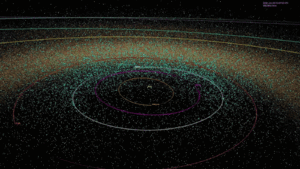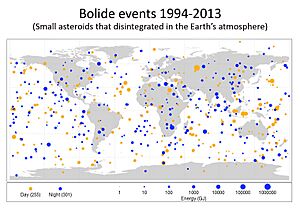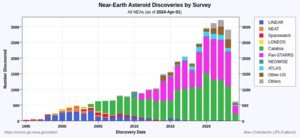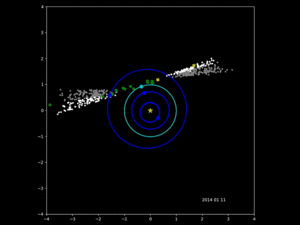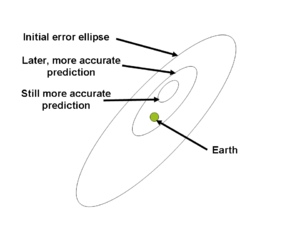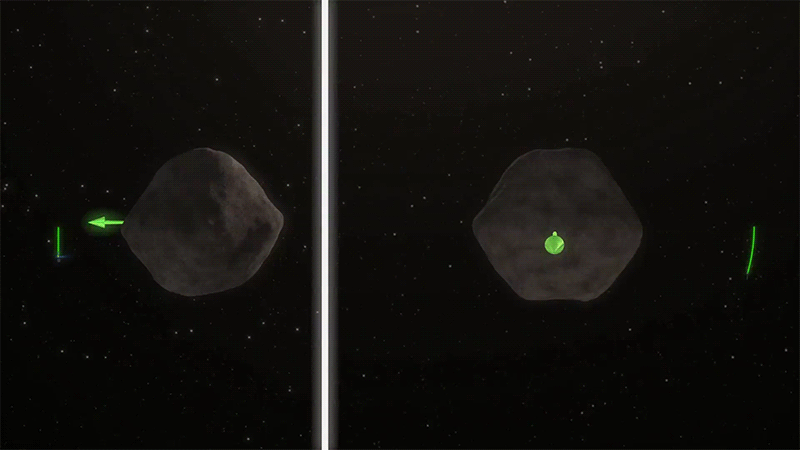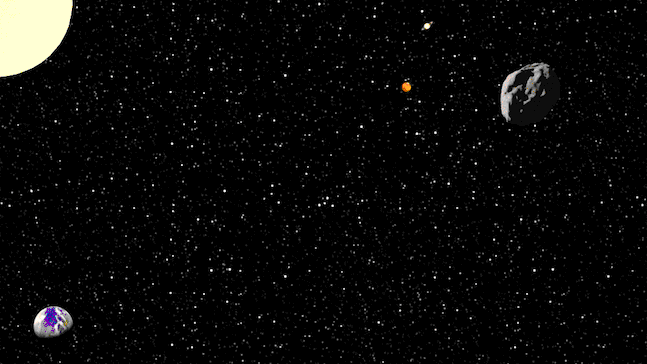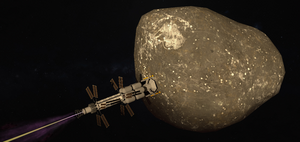Asteroid impact avoidance facts for kids
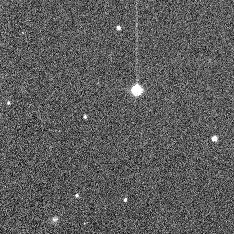
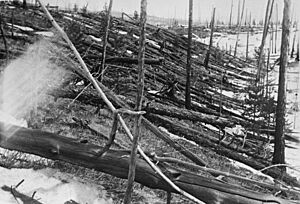
Asteroid impact avoidance means finding ways to stop near-Earth objects (NEOs) from hitting Earth. If a very large asteroid or other space object hits Earth, it could cause huge tsunamis or many firestorms. It could also create an "impact winter." This happens when a lot of dust and debris block sunlight.
About 66 million years ago, an object about 10 kilometers (6 miles) wide hit Earth. This created the Chicxulub crater. Scientists believe this event caused the Cretaceous–Paleogene extinction event. This is when all non-bird dinosaurs died out.
The chance of a big collision soon is low. But it is almost certain that one will happen eventually. This is unless we take steps to protect Earth. Events like Comet Shoemaker-Levy 9 hitting Jupiter and the Chelyabinsk meteor in 2013 have shown us these dangers. More NEOs are being found and tracked. The movie Don't Look Up also helped people learn about avoiding NEOs. People are much more aware of this threat now. But more work is needed to protect us from a major asteroid impact.
In 2016, a NASA scientist warned that Earth was not ready for such an event. In April 2018, the B612 Foundation said, "It's 100 percent certain we'll be hit by a devastating asteroid, but we're not 100 percent sure when." Also in 2018, physicist Stephen Hawking wrote in his last book that an asteroid collision was the biggest threat to our planet.
Scientists have described several ways to avoid an asteroid impact. There are two main ideas. One is to change the object's path so it misses Earth. The other is to break it up into smaller pieces. These smaller pieces would then either miss Earth or be small enough to burn up in our atmosphere.
However, in March 2019, scientists reported that asteroids might be harder to destroy than first thought. An asteroid could reassemble itself due to gravity after being broken apart. In May 2021, NASA astronomers said that 5 to 10 years of preparation might be needed to avoid a "virtual impactor." This was based on a practice exercise at the 2021 Planetary Defense Conference.
In 2022, NASA's Double Asteroid Redirection Test (DART) spacecraft hit Dimorphos. This reduced the asteroid moon's orbit time by 32 minutes. This mission was the first successful attempt to change an asteroid's path. In 2027, China plans to launch a mission to the near-Earth object 2015 XF261. The impact is expected in April 2029.
Contents
How do we stop an asteroid?
Experts told the United States Congress in 2013 that NASA would need at least five years to get ready for a mission to stop an asteroid. In June 2018, the US National Science and Technology Council warned that the United States was not ready for an asteroid impact. They then created a plan called the "National Near-Earth Object Preparedness Strategy Action Plan." This plan helps the US get ready.
Most efforts to deflect a large object need years or even decades of warning. This gives us time to prepare a project to avoid a collision. No special planetary defense hardware has been built yet. Scientists estimate that a small change in speed is enough to deflect an object. For example, if we have many years before impact, only tiny speed changes are needed.
NASA's DART mission was the world's first full-scale test. It checked technology for defending Earth against possible asteroid or comet dangers. It launched on a SpaceX Falcon 9 rocket from California.
An impact by a 10-kilometer (6-mile) asteroid has caused extinction-level events in the past. This is because it causes huge damage to life on Earth. Comets entering our inner Solar System also pose a threat. A long-period comet would hit much faster than a near-Earth asteroid. This would make its impact much more destructive. Also, we would likely only have a few months' warning. Impacts from objects as small as 50 meters (164 feet) are more common. They can cause extreme regional damage, like the Barringer crater.
Knowing what an object is made of helps decide the best strategy. Missions like the 2005 Deep Impact probe and the Rosetta spacecraft have given us important information. In October 2022, a new method was suggested. It maps the inside of a dangerous asteroid to find the best spot to hit it.
US Government Efforts
Efforts to predict asteroid impacts have focused on surveying the sky. In 1992, a NASA workshop looked at how to stop objects that could hit Earth. A report in 1992 suggested a Spaceguard Survey. This survey would find, check, and track Earth-crossing asteroids. It was hoped to find 90% of objects larger than one kilometer within 25 years.
In 1998, NASA officially aimed to find and list 90% of all NEOs that are 1 kilometer (0.6 miles) or larger by 2008. This size was chosen because an impact from an object smaller than 1 kilometer could cause major local damage. But it would likely not cause a worldwide disaster. An object much larger than 1 kilometer could cause worldwide damage. It could even lead to humans dying out. NASA's commitment led to funding for NEO searches. They made good progress by 2008. However, in 2009, several NEOs about 2 to 3 kilometers (1.2 to 1.9 miles) wide were found. This showed that large objects were still out there.
George Brown Jr., a US Representative, supported planetary defense projects. He said that if we find an asteroid big enough to cause a mass extinction and change its path, it would be one of the most important things humans have ever done.
Because of Congressman Brown's support, a bill was named after him: The George E. Brown Jr. Near-Earth Object Survey Act. This bill aimed to "detect, track, catalogue, and characterize certain near-Earth asteroids and comets." It became part of the NASA Authorization Act of 2005. This law said NASA should find and track NEOs equal to or greater than 140 meters (459 feet) in diameter. The goal was to complete 90% of this catalog within 15 years.
Current Projects
The Minor Planet Center in Cambridge, Massachusetts, has been listing asteroid and comet orbits since 1947. Other surveys now help find near-Earth objects (NEOs). Many of these are funded by NASA's Near Earth Object program. One well-known program is LINEAR, which started in 1996. By 2004, LINEAR was finding tens of thousands of objects each year. It accounted for 65% of all new asteroid discoveries. LINEAR uses two one-meter telescopes and one half-meter telescope in New Mexico.
The Catalina Sky Survey (CSS) is in Arizona. It uses two telescopes. In 2005, CSS became the most successful NEO survey. It found more NEOs and dangerous asteroids each year than LINEAR. CSS found 564 NEOs in 2008.
Spacewatch uses a 90-centimeter (35-inch) telescope in Arizona. It was set up in 1980 by Tom Gehrels and Robert S. McMillan. It now has a 1.8-meter (71-inch) telescope to hunt for NEOs. The old 90-centimeter telescope has been improved.
Other NEO tracking programs include Near-Earth Asteroid Tracking (NEAT) and Lowell Observatory Near-Earth-Object Search (LONEOS). Pan-STARRS finished building its telescope in 2010 and is now actively observing.
The Asteroid Terrestrial-impact Last Alert System (ATLAS) scans the sky often. It aims to detect asteroids late in their orbit, when they are on a collision course. This would be too late for deflection. But it would still give time to evacuate and prepare the affected area on Earth.
Another project, supported by the European Union, is NEOShield. It looks at ways to prevent NEOs from hitting Earth. They want to design test missions for possible ways to stop NEOs. The project focuses on two main things:
- Developing technology for guiding spacecraft near asteroids and comets. This would help hit them with a fast kinetic impactor. It would also help observe them before, during, and after a deflection attempt.
- Improving how we describe NEOs. NEOShield-2 will observe NEOs to better understand their physical properties. It will focus on smaller ones that are most concerning. It will also find more objects suitable for missions to study and deflect them.
"Spaceguard" is the name for these programs. Some get NASA funding to meet a US Congress goal. This goal was to find 90% of near-Earth asteroids over 1 kilometer (0.6 miles) wide by 2008. A 2003 NASA study suggested spending US$250–450 million. This would find 90% of all near-Earth asteroids 140 meters (459 feet) and larger by 2028.
In October 2013, the United Nations Committee on the Peaceful Uses of Outer Space approved ways to deal with asteroid impacts. This included creating an International Asteroid Warning Network (IAWN). This network shares information on dangerous asteroids. The Space Missions Planning Advisory Group (SMPAG) coordinates studies on deflection technologies. It also oversees actual missions. This is because deflecting an asteroid often means its predicted impact point moves across different countries. The UN General Assembly supported IAWN in December 2023. IAWN's main job is to warn of a possible impact threat. This happens if there is more than a 1% chance of impact within 20 years for an object larger than about 10 meters (33 feet). As of January 30, 2024, there were 34,274 known NEOs. Of these, 2,395 are asteroids whose orbits bring them within 8 million kilometers (5 million miles) of Earth. They are also larger than about 140 meters (459 feet). But it is estimated that only about 44% of NEOs in that size range have been found so far.
NEODyS is an online database of known NEOs.
Sentinel Mission
The B612 Foundation is a private group in the United States. It works to protect Earth from asteroid strikes. Scientists, former astronauts, and engineers lead it.
This group has done research to find NEOs that could hit Earth. They also look for ways to change their path. The foundation's goal was to build a privately funded asteroid-finding space telescope called Sentinel. It was planned to launch in 2017–2018. However, the project was canceled in 2015. If Sentinel's infrared telescope had been in an orbit like Venus', it would have helped find dangerous NEOs. It would have listed 90% of those larger than 140 meters (459 feet).
Sentinel would have sent its data to scientific networks like NASA. The foundation also suggests using gravity tractors to deflect dangerous NEOs. This idea was partly created by the group's CEO, physicist and former NASA astronaut Ed Lu.
Future Projects
Orbit@home aimed to use many computers to find the best search strategy. On February 16, 2013, the project stopped due to lack of funding. However, on July 23, 2013, NASA chose it for funding. It was supposed to restart in early 2014. As of July 13, 2018, the project's website says it is offline.
The Vera C. Rubin Observatory is expected to start a detailed, high-resolution survey in the fall of 2025.
Finding Asteroids from Space
On November 8, 2007, a US House of Representatives committee looked at NASA's Near-Earth Object survey program. NASA officials suggested using the Wide-field Infrared Survey Explorer (WISE).
WISE surveyed the sky using infrared light. Asteroids absorb sunlight and can be seen in infrared. WISE was used to find NEOs. It was expected to find 400 NEOs (about two percent of the total) within its one-year mission.
NEOSSat is a small satellite launched in February 2013 by the Canadian Space Agency (CSA). It hunts for NEOs in space. Also, Near-Earth Object WISE (NEOWISE), an extension of the WISE mission, started in September 2013. It hunts for asteroids and comets close to Earth's orbit.
Deep Impact Mission
Research from March 26, 2009, described how scientists found an asteroid in space before it hit Earth. This allowed computers to figure out where it came from and when and where its pieces would land. The 4-meter (13-foot) asteroid, called 2008 TC3, was first seen by the Catalina Sky Survey telescope on October 6, 2008. Predictions correctly said it would hit 19 hours later in the Nubian Desert of northern Sudan.
Some possible threats have been found, like 99942 Apophis. In 2004, it briefly had about a 3% chance of hitting Earth in 2029. More observations later showed this chance was zero.
Double Asteroid Redirection Test (DART)
On September 26, 2022, DART hit Dimorphos. This reduced the asteroid moon's orbit time by 32 minutes. This mission was the first successful attempt to change an asteroid's path.
China's 2019 VL5 Asteroid Mission
In 2025, China's CNSA plans to launch a mission to the near-Earth object 2019 VL5. This asteroid is 30 meters (98 feet) wide. The mission will launch on a Long March 3B rocket. It will carry both an impactor and an observer spacecraft.
How we calculate impact chances
The diagram shows where an asteroid might be when it gets closest to Earth. At first, with only a few observations, the error area is very large and includes Earth. More observations make the error area smaller. But it might still include Earth. This makes the predicted impact chance go up. This is because Earth now covers a bigger part of the error area. Finally, even more observations (often using radar) make the area shrink. This shows that Earth is outside the error area, and the impact chance is almost zero.
For asteroids that are truly on track to hit Earth, the predicted impact chance keeps going up with more observations. This similar pattern makes it hard to tell the difference between asteroids that will only come close and those that will actually hit. This makes it hard to decide when to warn people. Getting more certainty takes time, which means less time to react. But warning too soon risks a false alarm. This could make people not believe warnings later, like in the story of the Boy Who Cried Wolf.
Ways to avoid a collision
When choosing how to avoid a collision, we think about cost, risk of failure, how complex it is, if the technology is ready, and how well it works. Methods can be different based on how they stop the asteroid (deflection or breaking it up). They also differ by energy source (kinetic, electromagnetic, gravity, solar/thermal, or nuclear). And by how they approach the asteroid (intercepting it, meeting it, or from a distance).
Strategies fall into two main groups: breaking up the asteroid or delaying it. Breaking up the asteroid aims to make it harmless by shattering it. The pieces then either miss Earth or are small enough to burn up in the atmosphere. Delaying the asteroid uses the fact that both Earth and the asteroid are moving in orbit. An impact happens when both reach the same point at the same time. Earth is about 12,750 kilometers (7,922 miles) wide. It moves about 30 kilometers per second (18.6 miles per second) in its orbit. So, it travels its own diameter in about 425 seconds, or just over seven minutes. Delaying or speeding up the asteroid's arrival by this much time can make it miss Earth.
Collision avoidance strategies can also be direct or indirect. Direct methods, like nuclear explosives or kinetic impactors, quickly hit the asteroid. Direct methods are often cheaper and faster. They work for short-notice and long-notice threats. They are best for solid objects that can be pushed. But for kinetic impactors, they are not very good against large, loosely held "rubble piles." Indirect methods, like gravity tractors or attaching rockets, are much slower. They need to travel to the object, change course, and then slowly change the asteroid's path.
Many NEOs are thought to be "flying rubble piles." They are only loosely held together by gravity. A typical spacecraft hitting one might just break it up without changing its course enough. If an asteroid breaks into pieces, any piece larger than 35 meters (115 feet) across would not burn up in the atmosphere. It could still hit Earth. Tracking thousands of small pieces would be very hard. However, breaking it up would be better than doing nothing and letting the larger object hit Earth.
Computer simulations in 2011–2012 showed that if enough energy was delivered quickly, like from a nuclear explosion, any asteroid fragments would not come back together. Instead, they would fly away from the parent body and move off an Earth-impact path.
Nuclear Explosives
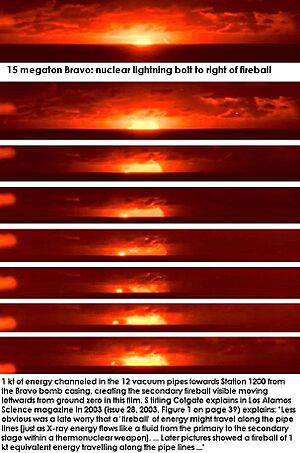
Using a nuclear explosive device near, on, or slightly under the surface of a dangerous space object is a possible way to deflect it. The best height for the explosion depends on the object's makeup and size. The goal is not to vaporize the whole NEO. If the threat is a "rubble pile," detonating the device above the surface can prevent it from breaking apart. The energy from the explosion (neutrons and X-rays) hits the object's surface. This turns the surface material into hot gas, like a rocket engine exhaust. This gas pushes the object, changing its speed and "nudging" it off course. This follows Newton's third law. Depending on the explosive's power, this "rocket exhaust" effect would change the object's orbit enough for it to miss Earth.
A mission called Hypervelocity Asteroid Mitigation Mission for Emergency Response (HAMMER) has been suggested. As of 2023, there are no updates on HAMMER. However, NASA's 2023 Planetary Defense Strategy and Action Plan says it is important to keep studying nuclear energy for deflecting or destroying asteroids. This is because it is currently the only option if scientists have only a few months or years of warning. The report also says that legal and policy issues need to be researched.
Stand-off Approach
If an object is very large but is a loose "rubble pile," one idea is to detonate one or more nuclear devices next to it. This would be about 20 meters (66 feet) or more above its surface. This way, the object would not break apart. If done far enough in advance, the force from enough nuclear blasts would change the object's path enough to avoid an impact. This is based on computer simulations and tests with meteorites.
In 1967, students at the Massachusetts Institute of Technology (MIT) designed a way to stop a hypothetical impact from the asteroid 1566 Icarus. This asteroid is 1.4 kilometers (0.9 miles) wide and sometimes comes close to Earth. To do this within 18 months, they thought of using modified Saturn V rockets. These rockets would carry nuclear devices in the 100-megaton range. This study was called Project Icarus. It inspired the 1979 film Meteor.
A NASA study in 2007 said:
Nuclear stand-off explosions are 10–100 times more effective than other options. Other ways using nuclear explosives on or under the surface might be more efficient. But they risk breaking the target NEO. They also have higher development and operations risks.
In the same year, NASA studied the asteroid 99942 Apophis (about 300 meters or 984 feet wide). They imagined it was on a path to hit Earth in 2029. The study said a "Cradle spacecraft" could deflect it. This spacecraft would carry six B83 devices. Each would have a 1.2-megaton yield. They would be launched by an Ares V rocket. Each B83 would explode 100 meters (328 feet) above the asteroid's surface, one after another, with hour-long breaks. The study said this could deflect NEOs 100-500 meters (328-1,640 feet) wide two years before impact. For larger NEOs, it would need at least five years' warning.
Research in 2021 showed that a lot of warning time is needed for an effective deflection mission. Ideally, several years or more. The more warning time, the less energy is needed to change the asteroid's path. The study also said that deflecting an asteroid is safer than destroying it. This is because there is less chance of debris falling to Earth. Researchers suggested that adjusting the neutron energy from a nuclear explosion is the best way to deflect an asteroid.
Surface and Underground Use
In 2011, Dr. Bong Wie at Iowa State University studied ways to deal with objects 50 to 500 meters (164 to 1,640 feet) wide when there was less than one year until impact. He concluded that a nuclear explosion or similar powerful event is the only method that can work against a very large asteroid in such a short time.
This led to the idea of a Hypervelocity Asteroid Intercept Vehicle (HAIV). This combines a kinetic impactor to make a first crater. Then, a nuclear explosion happens inside that crater. This would make the nuclear energy very efficient at pushing the asteroid.
A similar idea would use a nuclear device exploding on the surface to make the first crater. Then, the crater would act like a rocket nozzle to direct later nuclear explosions.
Wie claimed his computer models showed a 300-meter (984-foot) asteroid could be destroyed with one HAIV. This would need only 30 days' warning. The models also showed that less than 0.1% of the asteroid's debris would reach Earth. There have been few updates from Wie's team since 2014.
As of 2015, Wie worked with the Danish Emergency Asteroid Defence Project (EADP). This group wants to raise money to design, build, and store a non-nuclear HAIV spacecraft. For dangerous asteroids that are too large or too close for the non-nuclear HAIV, nuclear explosives (with 5% of the power of the stand-off strategy) would be used. This would happen under international supervision when needed.
A 2020 study said that a non-nuclear kinetic impact is less effective for larger and closer asteroids. However, researchers modeled a nuclear explosion near an asteroid's surface. This explosion would cover one side of the asteroid with X-rays. This energy would push the asteroid in a chosen direction. The lead researcher, Dave Dearborn, said a nuclear impact offers more flexibility. The energy output can be adjusted for the asteroid's size and location.
Comet Deflection
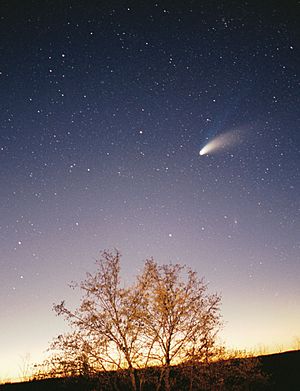
— Lord Byron
After the Shoemaker-Levy 9 comet hit Jupiter in 1994, Edward Teller suggested something. In 1995, he proposed to US and Russian weapons designers that they work together. They would design a one-gigaton nuclear explosive device. This would be as powerful as a 1-kilometer (0.6-mile) asteroid hitting Earth. This device would weigh about 25–30 tons. It would be light enough for the Energia rocket. It could instantly vaporize a 1-kilometer asteroid. It could also change the path of very large asteroids (over 10 kilometers or 6 miles wide) with only a few months' notice. With one year of notice, and if intercepted near Jupiter, it could also deal with rare short-period comets. These comets can come from the Kuiper belt and pass Earth within two years. For these comets, with an estimated maximum diameter of 100 kilometers (62 miles), Chiron was used as a hypothetical threat.
In 2013, the national laboratories of the US and Russia agreed to work together on asteroid defense. This agreement was meant to go along with the New START treaty. However, Russia stopped its part in the treaty in 2023. As of April 2023, there has been no official update on how this affects related agreements.
Current Capabilities
As of late 2022, the most likely and effective way to deflect an asteroid does not use nuclear technology. Instead, it uses a kinetic impactor to redirect the asteroid. This showed promise in the NASA DART mission. For nuclear technology, simulations have been run. They look at using neutron energy from a nuclear device to redirect an asteroid. These simulations showed promise. One study found that increasing the neutron energy had a clear effect on the asteroid's travel angle. However, there has not been a real-world test of this possibility as of April 2023.
Kinetic Impact
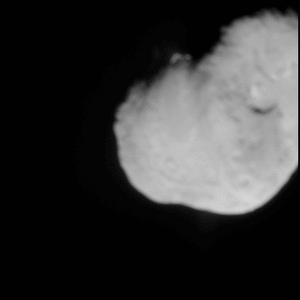
Hitting an asteroid with a large object, like a spacecraft or another near-Earth object, is another way to stop a coming NEO impact. A heavy object close to Earth could be sent to collide with the asteroid. This would knock it off course.
When the asteroid is still far from Earth, one way to deflect it is to directly change its momentum. This is done by crashing a spacecraft into it.
A NASA study in 2007 said:
Non-nuclear kinetic impactors are the most developed approach. They could be used in some deflection scenarios. Especially for NEOs that are a single small, solid body.
This method was used by DART. It was also used by NASA's Deep Impact probe for a different reason (to study a comet's structure). It involves launching a spacecraft at the near-Earth object. The asteroid's speed changes because of the law of conservation of momentum:
Here, V1 is the spacecraft's speed. V2 is the asteroid's speed before impact. V3 is the speed after impact. M1 and M2 are the masses of the spacecraft and the asteroid. These speeds are vectors, meaning they have both speed and direction.
The European Union's NEOShield-2 Mission is also studying the Kinetic Impactor method. This method works by deflecting the NEO or asteroid after it is hit by an impactor spacecraft. The impactor crashes into the NEO at a very high speed, like 10 kilometers per second (6.2 miles per second) or more. The impactor's momentum is transferred to the NEO. This changes its speed and slightly moves it off course.
As of mid-2021, the modified AIDA mission was approved. The NASA Double Asteroid Redirection Test (DART) spacecraft launched in November 2021. Its goal was to hit Dimorphos (nicknamed Didymoon). This is the 180-meter (591-foot) minor-planet moon of the near-Earth asteroid 65803 Didymos. The impact happened in September 2022. Didymos was close to Earth then. This allowed telescopes and radar on Earth to watch the event. The impact changed Dimorphos's orbit speed and time enough to be measured from Earth. This showed for the first time that we can change the orbit of a small asteroid. This size is most likely to need active defense in the future. The DART system showed in March 2023 that asteroids can be safely redirected without nuclear means. The second part of the AIDA mission, the ESA HERA spacecraft, was approved by ESA member states in October 2019. It will reach the Didymos system in 2026. It will measure Dimorphos's mass and the exact effect of the impact. This will help us better understand how the AIDA mission applies to other targets.
Asteroid Gravity Tractor
Another way to deflect an asteroid without explosives is to move it slowly over time. A small but steady push can add up to move an object enough off its course. Edward T. Lu and Stanley G. Love suggested using a large uncrewed spacecraft hovering over an asteroid. This spacecraft would use gravity to pull the asteroid into a safe orbit. Both objects pull on each other with gravity. But the spacecraft can push back with its own thrusters, like an ion thruster. So, the asteroid is slowly pulled towards the spacecraft, slightly changing its orbit. This method is slow. But it works no matter what the asteroid is made of or how fast it spins. "Rubble pile" asteroids are hard to deflect with nuclear explosions. A pushing device would be hard to attach to a fast-spinning asteroid. A gravity tractor would likely need to stay next to the asteroid for several years to work.
A NASA study in 2007 said:
"Slow push" methods are the most expensive. They are also the least ready technologically. Their ability to travel to and deflect a dangerous NEO would be limited. This is unless missions can last many years to decades.
Ion Beam Deflection
Another "contactless" way to deflect an asteroid uses a focused ion thruster. This thruster would be on a spacecraft hovering near the asteroid. The ions hitting the asteroid's surface create a slow but continuous force. This can deflect the asteroid in a similar way to the gravity tractor, but with a lighter spacecraft.
Focused Solar Energy
H. J. Melosh and I. V. Nemchinov suggested deflecting an asteroid or comet by focusing solar energy onto its surface. This would vaporize material, creating a push. This method would first need a space station with large, curved mirrors. These would be like those used in solar furnaces.
Using highly focused sunlight can deflect a global-threat asteroid within a year, even with short warning. This faster strategy might be needed if a danger is found late. It also offers the chance for more action if needed. Normal curved mirrors don't work well for focusing light on a giant, shadowing target in space. This is because the focal points spread out when the mirror is not perfectly aimed at the Sun. Also, placing a collector far from the target does not give enough focus because sunlight naturally spreads out.
To fix these problems, V.P. Vasylyev suggested a different mirror design: a ring-array concentrator. This collector has its focal area underneath, like a lens. This avoids the collector being shadowed by the target. It also reduces the risk of debris coating the mirror. If sunlight is focused about 5,000 times, the surface gets about 4-5 megawatts per square meter. This creates a pushing force of about 1,000 newtons. Intense vaporization of the rotating asteroid's surface under the focal spot would create a deep "canyon." This could help the escaping gas flow like a jet. This might be enough to deflect a 0.5-kilometer (0.3-mile) asteroid within several months. It would need no extra warning time. The ring-array collector would be about half the asteroid's diameter. For faster deflection of larger NEOs (1.3 to 2.2 kilometers or 0.8 to 1.4 miles), the collector size would be similar to the target's diameter. If there is more warning time, the collector can be much smaller.
Mass Driver
A mass driver is an automated system on an asteroid. It ejects material into space. This gives the object a slow, steady push and reduces its mass. A mass driver works by using a lot of "propellant" (the asteroid's own material) but very little power. This uses the asteroid against itself to avoid a collision.
The Modular Asteroid Deflection Mission Ejector Node (MADMEN) is an idea. It involves landing small unmanned vehicles, like space rovers, to break up small parts of the asteroid. They would use drills to break rocks and boulders from the surface. This debris would fly off very fast. Because no other forces act on the asteroid, these rocks would push the asteroid off course very slowly. This process takes time but could be very effective if done right. The idea is that when using local material as propellant, the amount of propellant is not as important as the amount of power, which is likely limited.
Rocket Engines
Attaching any spacecraft propulsion device would have a similar effect. It would give a push, possibly forcing the asteroid onto a path away from Earth. A rocket engine in space that can give a push of 106 N·s (for example, adding 1 km/s to a 1000 kg vehicle) would have a small effect on a relatively small asteroid. This is because the asteroid is roughly a million times heavier. Chapman, Durda, and Gold's paper calculated deflections using existing chemical rockets sent to the asteroid.
Such direct force rocket engines are usually planned to use very efficient electrically powered spacecraft propulsion. Examples include ion thrusters or VASIMR.
Asteroid Laser Ablation
Similar to nuclear devices, it might be possible to focus enough laser energy on an asteroid's surface. This would cause flash vaporization or ablation. This would create a push or remove asteroid mass. This idea, called asteroid laser ablation, was discussed in a 1995 paper called "Preparing for Planetary Defense." It was also in a 1996 paper called "Planetary Defense: Catastrophic Health Insurance for Planet Earth." Early ideas include C. R. Phipps' "ORION" concept from 1996 and NASA's 2005 concept, Comet Asteroid Protection System (CAPS). These systems usually need a lot of power, like what could come from a Space-Based Solar Power Satellite.
Another idea is Phillip Lubin's DE-STAR proposal:
- The DE-STAR project is a concept for a modular, solar-powered laser array. It would use 1-micrometer, near infrared wavelength lasers. The design calls for the array to eventually be about 1 square kilometer (0.4 square miles) in size. Its modular design means it could be launched in pieces and put together in space. When it is small, it could deal with smaller targets. It could also help solar sail probes and clean up space debris.
Other Ideas
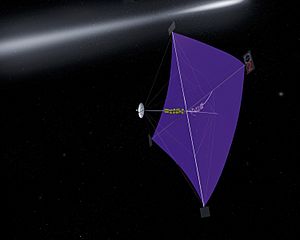
- Wrapping the asteroid in a sheet of reflective plastic, like aluminized PET film, to act as a solar sail.
- "Painting" or dusting the object with titanium dioxide (white) to change its path by increasing reflected radiation pressure. Or using soot (black) to change its path using the Yarkovsky effect.
- Planetary scientist Eugene Shoemaker suggested in 1996 deflecting an asteroid by releasing a cloud of steam in its path. This would hopefully slow it down gently. Nick Szabo in 1990 had a similar idea, "cometary aerobraking." This involved aiming a comet or ice structure at an asteroid. Then, vaporizing the ice with nuclear explosives to create a temporary atmosphere in the asteroid's path.
- "Coherent digger array" involves multiple 1-ton flat tractors. They would dig and expel asteroid soil mass as a coordinated fountain. This coordinated activity could propel and deflect the asteroid over years.
- Attaching a tether and ballast mass to the asteroid to change its path by shifting its center of mass.
- Magnetic flux compression to magnetically slow down or capture objects with a lot of meteoric iron. This would involve putting a wide coil of wire in its orbital path. When the object passes through, Inductance creates an electromagnet to pull it.
Concerns about Deflection Technology
Carl Sagan, in his book Pale Blue Dot, worried about deflection technology. He noted that any method that can deflect objects away from Earth could also be used to divert harmless objects toward the planet. He thought about the history of bad leaders and how the true goals of a project could be hidden from scientists. He believed Earth was at greater risk from a human-made impact than a natural one. Sagan suggested that deflection technology should only be developed in a real emergency.
All low-energy deflection technologies have precise control. This makes it possible to add just the right amount of energy to steer an asteroid that was only going to pass close by toward a specific target on Earth.
According to former NASA astronaut Rusty Schweickart, the gravitational tractor method is debated. This is because as an asteroid's path is changed, the point on Earth where it might hit would slowly shift across different countries. So, the threat to the whole planet would be reduced. But it would be at the cost of some specific countries' safety. Schweickart believed that choosing how to "drag" the asteroid would be a difficult diplomatic decision.
Studies on the uncertainty of nuclear deflection show that being able to protect the planet does not mean being able to target the planet. A nuclear explosion that changes an asteroid's speed by 10 meters per second (plus or minus 20%) would be enough to push it out of an Earth-impacting orbit. However, if the uncertainty of the speed change was more than a few percent, there would be no way to direct the asteroid to a particular target.
Also, there are legal concerns about launching nuclear technology into space. In 1992, the United Nations passed a resolution with strict rules for sending nuclear technology to space. This included preventing space contamination and protecting people on Earth from potential fallout. As of 2022, the UN is still looking at the safety and legal issues of launching nuclear-powered items into space. This is especially true as more private groups are involved in space travel. The UN Committee on Peaceful Uses of Outer Space recently stressed the importance of the previous resolution. It said member states are responsible for ensuring everyone's safety regarding nuclear power in space.
Timeline of Planetary Defense
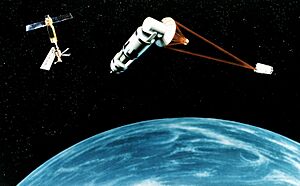
- In their 1964 book, Islands in Space, Dandridge M. Cole and Donald W. Cox wrote about the dangers of planetoid impacts. They talked about both natural impacts and those that might be caused on purpose. They argued for listing minor planets and developing ways to land on, deflect, or even capture them.
- In 1967, students at MIT did a study called "Project Icarus." It was about a mission to stop a hypothetical impact by asteroid 1566 Icarus. This study was published and brought asteroid impact into public view for the first time.
- In the 1980s, NASA studied evidence of past impacts on Earth and the risk of future ones. This led to a program that maps objects in the Solar System that cross Earth's orbit and are large enough to cause serious damage.
- In the 1990s, the US Congress held hearings to discuss the risks and what to do. This led to a US$3 million yearly budget for programs like Spaceguard and the near-Earth object program, managed by NASA and USAF.
- In 2005, several astronauts published an open letter. They called for a united effort to develop ways to protect Earth from cosmic collisions.
- In 2007, it was estimated that about 20,000 objects could cross Earth's orbit. These were 140 meters (459 feet) or larger. On average, one of these will hit Earth every 5,000 years, unless we take steps to prevent it. It was expected that by 2008, 90% of objects 1 kilometer (0.6 miles) or more in diameter would be found and watched. The goal to find and watch all objects 140 meters (459 feet) or larger was expected to be complete around 2020. By April 2018, astronomers had spotted over 8,000 near-Earth asteroids that are at least 460 feet (140 meters) wide. It is estimated that about 17,000 such asteroids are still unfound. By 2019, over 19,000 near-Earth asteroids of all sizes had been found. About 30 new ones are found each week.
- The Catalina Sky Survey (CSS) is one of NASA's funded surveys. It helps meet a 1998 US Congress goal to find and list 90% of all NEOs larger than 1 kilometer (0.6 miles) by the end of 2008. CSS found over 1,150 NEOs from 2005 to 2007. On November 20, 2007, they found an asteroid, 2007 WD5. It was first thought to have a chance of hitting Mars on January 30, 2008. But more observations showed it would miss Mars by 26,000 kilometers (16,156 miles).
- In January 2012, after object 2012 BX34 passed close by, a paper was released. It was called "A Global Approach to Near-Earth Object Impact Threat Mitigation." Researchers from many countries discussed the "NEOShield" project.
- In November 2021, NASA launched a program with a new goal for planetary defense. Many old methods aimed to completely destroy the asteroid. But NASA and others thought this was too risky. So, they funded the Double Asteroid Redirection Test (DART) mission. This mission launched a small unmanned spacecraft to crash into an asteroid. The goal was to break it up or push it away from Earth.
- In January 2022, the NASA-funded Asteroid Terrestrial-impact Last Alert System (ATLAS) reached a new milestone. ATLAS is a system operated by the University of Hawaiʻi. It became the first survey that can search the entire dark sky every 24 hours for NEOs that could hit Earth. ATLAS now has four telescopes. It has expanded its reach to the southern hemisphere.
- As of March 1, 2023, NASA proved that DART works. It successfully hit an asteroid moving at high speeds and redirected its course. This data showed that we can successfully move an asteroid up to half a mile (0.8 kilometers) in diameter.
More to Explore


